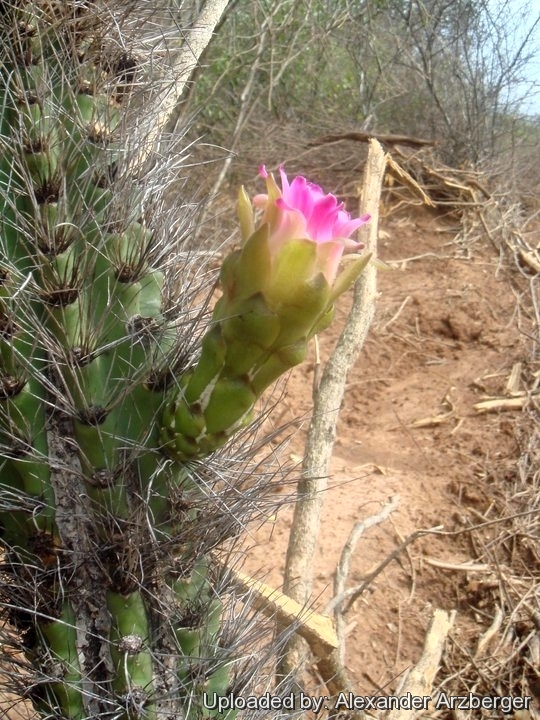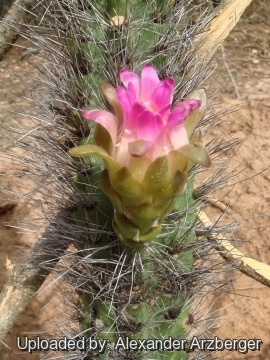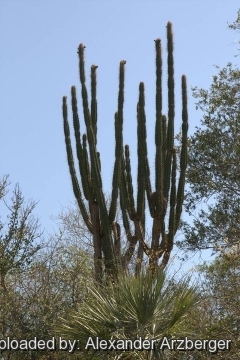




Your support is critical to our success.

Origin and Habitat: Browningia caineanaSN|6314]]SN|6314]] is known from Bolivia, where it occurs in Cochabamba and Santa Cruz, and from northeastern Paraguay.
Altitude range: It occurs at elevations between 100 and 1100 metres above sea level.
Habitat and Ecology: This cactus grows on sandy soils, in dry thickets that are not suitable for agricultural activities. It grows together with Stetsonia coryneSN|19128]]SN|19128]], Cleistocactus baumanniiSN|4742]]SN|4742]], Monvillea cavendishiiSN|7722]]SN|7722]], among sparse trees and shrubs covered by Tillandsia and many other epiphytes. Castellanosia caineanaSN|6315]]SN|6315]] is widely distributed, locally abundant, and there are no major threats affecting it.
Synonyms:
- Browningia caineana (Cárdenas) D.R.Hunt
- Castellanosia caineana Cárdenas
ENGLISH: Río Caine browningia
FRENCH (Français): browningia du Río Caine
SPANISH (Español): el carapari (Bolivia)
Description: Browningia caineanaSN|6314]]SN|6314]] (Castellanosia caineanaSN|6315]]SN|6315]]) is a treelike cactus, branching basally, to 5-6 m high. The stems are cylindrical with 9 rounded ribs. Flowers develops towards top of branches. Flowers are deep red, diurnal somewhat funnel-shaped. This species differs from Cephalocereus by the full lack of Cephaliums or Pseudocephaliums and even of hair on the flowering areoles. The most striking peculiarity of this species is the heteromorphic spination, with lower part of stems bearing strong spines and apical flowering segments producing only tufts of fine bristles.
Derivation of specific name: “caineana” for the occurrence in the valley of the Rio Caine.
Stems: Long cylindrical, clearly jointed, somewhat flexible, something bent, grey-green, tapering slightly. Stem segments (joints) 30-40 cm long, 8-11 cm in diameter.
Ribs: 9, divided by deep constrictions into sections.
Areoles: Circular grey, round, to 3 cm apart.
Spines: Noticeably dimorphic, the spines on juvenile (lower, vegetative or sterile portion) of stems are very different looking from those of the upper, flowering portion of stems.
Spines of vegetative stems: Brown or black, stout, subulate, but also somewhat aciculate or bristle-like, unequal. Radial spines 15-16, 8-40 mm long. Central spines 3-4, enlarged at the base 4-7 cm long.
Spines of flowering stems (in areoles above the fourth constriction): About 25, bristly, flexible of different lengths, white, grey, brown or blackish, 8-40 mm long.
Flowers: Purplish red, 3-5 cm long, produced above the the 4(-5) stems constrictions from the middle of the bristle-carrying areoles. Flower buds naked. Ovary and tube with wide overlapping abruptly tapered scales, with dense creamy white felt in their axils. The outer perianth segments are obtuse, the inner broadly lanceolate (Acute) and purple. Anther long and flattened, pale yellow. Style more or less prominent, thick, pink. Stigma-lobes 15 pink white.
Fruits: Globose, greenish yellow, to 30 m long, 25 mm thick, slightly tapering towards the dried flower remnant. Scales wide, overlapping like roof tiles, with dense, short and cream felt. Pulp dark yellow toxic.
Seeds: small, 1 mm long, reddish brown.
Bibliography: Major references and further lectures
1) Edward Anderson “The Cactus family” Timber Press, Incorporated, 2001
2) James Cullen, Sabina G. Knees, H. Suzanne Cubey "The European Garden Flora Flowering Plants: A Manual for the Identification of Plants Cultivated in Europe, Both Out-of-Doors and Under Glass" Cambridge University Press, 11/Aug/2011
3) Oakley, L. & Pin, A. 2013. Castellanosia caineana. The IUCN Red List of Threatened Species 2013: e.T152348A626692. http://dx.doi.org/10.2305/IUCN.UK.2013-1.RLTS.T152348A626692.en. Downloaded on 10 July 2016.
4) David R Hunt; Nigel P Taylor; Graham Charles; International Cactaceae Systematics Group. "The New Cactus Lexicon" dh books, 2006
5) M.M. Grandtner, Julien Chevrette “Dictionary of Trees, Volume 2: South America: Nomenclature, Taxonomy and Ecology” Academic Press, 21 September 2013
6) Clive Innes “Complete Handbook of Cacti and Succulents” Van Nostrand Reinhold Company, 01 December 1981
7) A.F.H. Buining “Interessante cactusgebieden in Bolivia (2)” in: Succulenta 82-85, 1975 and “Interessante cactusgebieden in Bolivia (6)” 208-212 1975
8) Von Friedrich Hilberath (Wesseling) “Neubeschreibungen der ausländischen Literatur” KAKTEEN UND ANDERE SUKKULENTEN - Monatlich erscheinendes Organ der Deutschen Kakteen-Gesellschaft, 10(1): p. 6, January 1959

Browningia caineana Photo by: Alexander Arzberger

Browningia caineana Photo by: Alexander Arzberger
Cultivation and Propagation: Browningia caineanaSN|6314]]SN|6314]] (Castellanosia caineanaSN|6315]]SN|6315]]) is a species which seems to be very rare in cultivation.
Soil: Grow it in a rich and particularly draining substratum, as it is very sensitive to rottenness when in presence of humidity and low temperatures and let the soil dry out between waterings.
Repotting: Repot in the spring, when their roots become cramped. Generally, they should be repotted every other year in order to provide fresh soil. After repotting, do not water for a week or more. Use pot with good drainage.
Fertilization: It grows much faster with a low nitrogen content fertilizer in spring and summer.
Watering: Water regularly from March till October, the thin, fibrous roots suffer if there is humidity, therefore the plant should be watered only when the surrounding terrain is dry. Keep dry as soon as the temperature starts dropping in October and keep it perfectly dry in winter at temperatures from 5 to 15 degrees centigrade. Preferable not to water on overcast days, humid days or cold winter days.
Hardiness: They need to be kept in a cool place during winter rest and are somewhat resistant to frost if kept on the dry side prior to, and during, cold weather with little danger of being killed (unlike most of the Pilosocereus species). In cultivation it is better not to expose it to temperatures lower than 5° C, even if in an aerated and protected location. In the rest period no high atmospheric humidity!!
Sun Exposure: It need full sun exposures with ample airflow for best appearance.
Maintenance: Older plants often need to be supported as they tend to collapse under their own weight.
Propagation: Almost exclusively by seed as the branches cannot be used for cuttings or for grafting. The seeds can be sown in pots of fine, well-drained sandy soil, any time during the spring when temperatures are warm. The seedlings should not be disturbed until they are well rooted after which they can be planted separately in small pots.
| Your Actions | |
|---|---|
| Back to Browningia index | |
| Back to Cactaceae index | |
 |
Back to Trees Encyclopedia index |
Privacy stantement - Terms and conditions - How to cite - About us - Feedback - Donate


